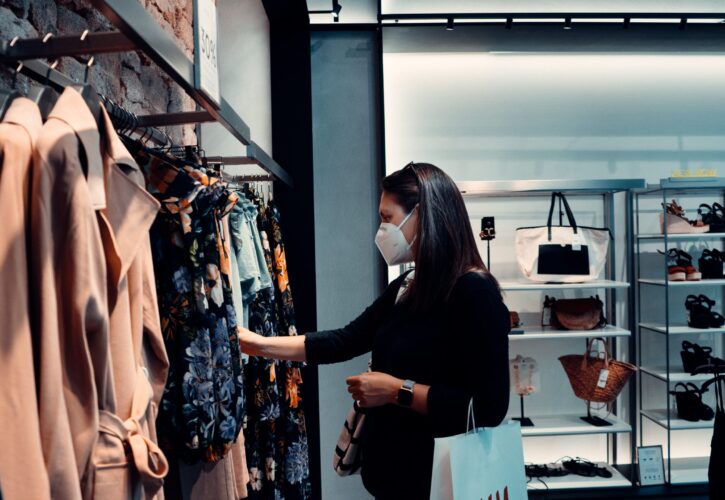
How Covid-19 has Changed Shopping and What Brands Need to do to Adapt
At the beginning of the pandemic people were forced to change their behaviour and how they shop. Social distancing incentivised online shopping and the new routine lead to new habits. The biggest increase in online sales were in the categories where physical stores were closed such as fashion, home and consumer electronics. (Think with Google)

Image Source: Think with Google
Lockdown restrictions, and in some cases a lack of stock, forced consumers to try new retailers. 60% of consumers globally say they have recently tried a new store, site, or brand—and most plan to stick with it (McKinsey, Facebook Safer Shopping report). For those who bought from new retailers, price (43%) convenience (36%) and speed (33%) were the main purchase drivers, with availability bring the most important factor. (Think with Google)
Online versus in-store
With the government guidelines and new rules for retailers, nearly half (48%) of customers in the U.K. faced an issue buying in-store, compared to 42% in 2019, whereas consumers facing issues while online shopping decreased from 41% in 2019 to 33% in 2020. (Think with Google) Ensuring seamless website user experience on both mobile and desktop becomes even more essential as users frustrated with in-store experience might decide to buy online.
Convenience was already the main motivation to buy online (83%) in 2019, but it became even more important (86%) in 2020 with ‘product delivery to my home’ being listed as the second biggest motivation to buy online (48%). Consumers listing convenience as a motivation to buy in-store decreased from 77% in 2019 to 69% in 2020. (Think with Google)

Despite the difference in behaviour for each demographic, 42% of UK consumers will shop more digitally while only 6% said they would shop more in-store.
With the uncertainty that COVID-19 is posing, people have become more financially aware. Globally, 80% of consumers say they are delaying a major purchase while 39% say they are waiting for a discount or sale to reignite their spending. Offering discounts and flexible paying is now key to stay competitive.
Increase in Online purchases
Digital and mobile adoption were already growing, but the social changes and restrictions imposed by COVID-19 have accelerated this trend, particularly encouraging older generations to embrace e-commerce.
Online research to support a purchase increased from 75% in 2019 to 84% in 2020. This was mainly driven by shoppers over 45 years old. (Think with Google).

Based on a recent report published by Facebook, 49% of users say they intend to shop online more, even after the outbreak with just 1 in 2 shoppers saying they are in a rush to return to physical stores.
The increase in online shopping is also directly related to an increase in mobile usage. 72% of Gen X and 50% of Boomers say they are spending more time on mobile during the COVID-19 outbreak. (GWI, April 2020). According to Facebook’s report, 78% of the online purchases they recently analysed took place on mobile.
An important trend emerging from the increase in online purchase is online safety. 71% of US in-store shoppers consider safety a priority when deciding where to shop (Kantar, Facebook Safer Shopping report).
This should be a long-term trend as people plan to continue practicing safe shopping long after the outbreak: (GWI, Facebook Safer Shopping report).
- Increase mobile payments
- Minimizing time in store
- Pre-store research
- BOPIS, curbside, etc.
- Self-service checkout
However, the importance of safety is not limited to bricks-and-mortar retail. Shifting purchase behaviours and the large number of new digital shoppers have led to a surge in cyber-crime and both businesses and consumers need to be increasingly aware of online attacks and fraud.
What businesses need to do to adapt?
- Build a website. It goes without saying that eCommerce is here to stay, and coronavirus has accelerated its growth into different consumer groups and different product categories. With automotive manufacturers trialling online showrooms, how long will it be before buying a car online becomes the norm?
- Invest in mobile UX. With mobile usage higher than ever, it is important to ensure the user journey as seamless as possible, avoiding friction points. On average, 82% of global mobile shoppers surveyed experience some problems while shopping so there is a significant space for improvement. (Facebook Seasonal Holidays Study).

- Safe shopping, more than ever, is key to drive sales. Ensure you are offering (and including on your website) safe options such as contactless delivery and click and collect.
- Ensure that your site is well protected against cyber attacks and that your customers’ data is not vulnerable
- As your physical stores reopen, ensure opening hours information is updated on your website, social networks and on Google My Business. This will allow shoppers to easily see any changes to your usual operating hours or conditions of opening.
- People are searching for offers and they want it now. Try including discounts and offers and ensure you have a competitive price.
- Recreate the best parts of the physical shopping experience online. Is your site a nice place to spend time? If not maybe trial some new forms of content. Is it easy to browse? If not focus on your UX. Is it easy to ask a question like you might to a shop assistant? If not, think about integrating Facebook Messenger, WhatsApp or chatbots in your website.
Behavioural changes are currently fast-moving, and these were some of the trends we believe will remain in a longer-term. However, keeping track of vertical specific trends and how government restrictions could be creating new habits is essential for businesses looking to plan their marketing strategy.
If consumers are commuting less and spending more time at home, allocating more investment towards digital, especially mobile is a must. At the same time, with the growing importance of digital and mobile, ensuring your website is delivering a good experience will avoid frustrated customers which in the long term could impact your brand image and trust.
Lastly but most importantly, during times where businesses are prioritising direct response over awareness campaigns, measurement and tracking should be the priority. Ensuring websites and apps are properly tracked, looking into different attribution models, and having clear KPIs are key to achieve the desirable results.
Sources
Think with Google – 8 ways consumers in the U.K. adapted their shopping behaviour this year
Facebook – 5 Global Shifts Shaping the Future Now
eMarketer – What Digital Shopping Habits in the UK May Look Like Post-Pandemic
Facebook Safer Shopping report
The 2020 Facebook Christmas Package report






